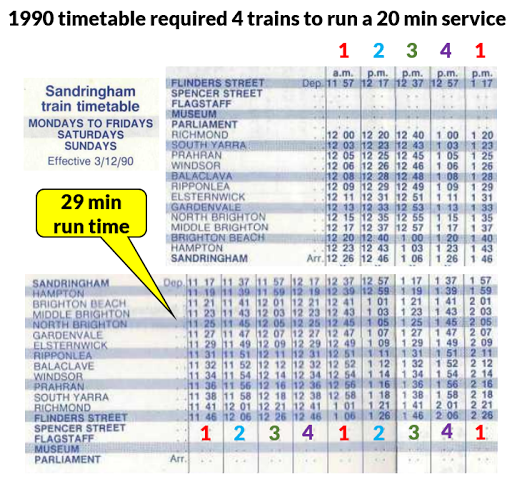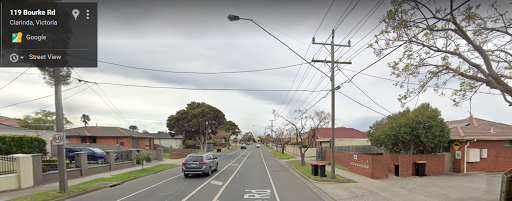There are often big gaps between what might be an ideal bus network for an area and what exists now. There won't be unlimited funds to run frequent buses on every street to every destination so choices will need to be made. What's decided will please some and displease others.
You can bet your life that when reforming bus networks you'll only hear from only those who feel worse off under a change. Along with their friends, even though they've never ridden a bus for years. That can make change harder than initially envisaged. It may even scare some ministers and governments from doing much at all, particularly before an election.
On the good side bus network reform is highly cost-effective, especially in some established areas where indirect and overlapping routes can be simplified and made more frequent for little money. It's also necessary in growth areas where existing routes stop short of new subdivisions, schools and shopping centres.
Trams rarely operate beyond the inner suburbs while trains serve only narrow ribbons further out. Thus the nearest public transport to most Melburnians is a bus. Efficient bus networks are essential if you wish to provide useful public transport to most people and jobs. That particularly includes outer suburbs which are being built at higher densities than was usual in the past and middle suburbs that are being redeveloped from predominantly houses to more townhouses and apartments.
Not long ago a billion dollars could build a massive transport infrastructure project. These days projects can cost tens of billions. Individual grade separations are $100 million or more each. Even smaller projects, like commuter parking, costs millions per site, or tens of thousands per individual uncharged for spot. This is a large per-passenger private benefit given how little is recouped from fares (capped at less than $2000 per year assuming use of a full fare 365 myki pass).
Along with walking and cycling infrastructure, buses are about the only things in transport that remain relatively cheap. A local government area with a population of about 200 000 can get its existing basic network upgraded to something substantially better for $10 million. Double that if you want even better operating hours and frequencies. Going the other way, if you only had $2 or 3 million then you could greatly upgrade one or two key routes and reform some others. If that's all the money you can get, don't turn it down.
These numbers are operational expenditures rather than capital expenditures like the big infrastructure projects. They need to be found each year otherwise the service stops. That commitment scares treasuries, whereas amounts for what might be seen as one-off projects may be easier to find, despite them being many many times larger. Still, if we're maxed out on the big projects, buses are the only remaining option if you're keen to quickly deliver improved service to many areas for low cost.
The need for parsimony leads to a conflict between what maximises patronage and what minimises political risk. The best bus network may involve route reform to optimise coverage and frequency for the largest population possible. However this ideal might be steered away from if there is wariness about the political risks of too big a change.
The latter happened in Adelaide. A bold citywide bus network proposal recently got abandoned following a political backlash and the premier's intervention. Adelaidians will thus be stuck with their often indirect, infrequent and confusing buses for the foreseeable future.
Melbourne had its Adelaide-type moment in 2015, when Transdev's proposed Greenfields network was abandoned. A period of reduced activity in bus network reform has since followed.
Perth, in contrast, has procedures that allow multiple and, when combined, transformative, bus network changes without attracting much controversy. This has endured over at least 15 or 20 years under governments of both persuasions.
Here are 10 ways for us to be more like Perth and less like Adelaide in delivering reformed and more useful bus networks.
1. Know the area whose buses you're trying to fix
A new bus network will never fly unless it's more useful than what's there now. Planners need to know local demographics and travel patterns so revised networks don't make things worse or over-service some streets. For example low income high density areas (including some outer areas like Tarneit and Craigieburn) justify more frequent service at all hours. Whereas some lower density rich areas with parallel train lines (eg Brighton) have frequent buses running at midnight that few use.
Localities with many older or less mobile people may value short walking distances more than high frequency. Other catchments may prefer directness, speed and frequency. Revised networks should seek to serve local hospitals, schools, shopping centres, train stations, jobs and residential communities with coverage and frequency (where justified) at least better than now.
2. Know what's wrong with the existing network
It's useless to try to make things better until you know what the current problems are. Otherwise a revised network may be a solution looking for a problem. A recent example is the ill-fated Mordialloc review, which, except for some school bus upgrades, was wisely not proceeded with. Other areas, such as the premier's seat of Mulgrave (below) have major issues that are high priority for an improved network.
Some problems can be seen just by looking at maps and timetables. For example routes that look indirect, irregular bus times that don't match trains or the lack of a Sunday service. Others, such as trip-level punctuality and patronage, require more detailed data. Talking to bus companies and councils can be helpful with regard to local road and traffic issues that delay buses.
Direct observation by planners can sometimes reveal excessive run times, poor patronage or inefficient usage of buses. Bus operators can vary in their openness on such matters. However knowing where inefficiencies lie is necessary to deliver the most upgrades for the least cost.
Before reforming a network planners should make themselves aware of local transport network issues by analysing requests and complaints, surveying local news and social media, reviewing the punctuality and patronage of existing routes, examining census and other data, site visits (including riding local buses) and talking to people.

3. Come up with several network options
It is human to create something and to love it. So much so that you get defensive protecting it. Your mind may close when others make suggestions. That can include planners and their revised bus networks. As an antidote it is wise to develop several network options and list their pros and cons. Then they become less wedded to one and are more open to ideas.
Some options will be more radical than others. Some might be simpler while others give more people direct access to a large shopping centre. Think of who will gain and lose from each and check it against what has been learned about the area. Be prepared for options to change. For example an initially attractive option might not be practical as roads are too narrow for buses. Or a hybrid option that solves several problems and is more generally acceptable may emerge.
You may end up with two or three refined and workable options. Any would represent a significant improvement the existing network and cost about the same. You may wish to throw them open for public comment and surveys. Asking people to choose can help with community engagement - more on this later.
4. Don't do too much at once (but don't stagnate either)
Adelaide tried to reform its whole bus network at once. Auckland, a similar city, split their reforms into eight regions done over three years. Perth is even more gradual, but the cumulative result is transformative with reviews being routine business.
Houston also did everything at once, but, unlike Adelaide, succeeded. However, because it has a stronger CBD and a weak rail network, Adelaide's bus ridership includes many middle class commuters coming from politically marginal seats. It also has an older population, with a median age of 39 versus Houston's 33. If age and 'middle classness' correlate with political clout, the hard time that Adelaide had may be more understandable.
Overall a staged approach presents less political risk and allows more consistent workflow than a 'blg bang' change. A model could be what we did in the 2006-2009 period with upgrades every few weeks to some small cluster of routes. Staging allows minor issues to be sorted out with less risk to the network as a whole.
5. Explain network changes by suburb
The first instinct people have when confronted with a new network is to find their house and see what's happened to their nearest stop and for trips they often make. This needs really good information eg detailed maps and information on service levels including operating hours and frequencies.
Adelaide didn't do well on that. Whereas Houston did. Its public information included dual trip planners on the old and new networks. People could plan test rides. This personalised information helped reassure people that the new network would be better, or at least no worse, for them. Reassurance is key to assuaging the fear of a new network.
Network changes should be explained at the street and suburb level. There should be notes describing alternatives where routes are split and how common trips would be improved.
Before and after network maps are essential. Ideally these should show more frequent routes as thicker lines. That better communicates cases where routes have been upgraded in the proposed network. Special detail is needed where stops are closed and people need to walk elsewhere to use the new network.
Communication should also stress improved operating hours, including new seven day service that a new network may extend. Feelings of wariness can be moderated if people see that there are 'swings and roundabouts' changes with good and bad rather than it being all bad.
6. Don't hide the bad stuff
Adelaide lost points here. The initial word was that 500 bus stops would shut. However this proved to be an understatement. It turned out that hundreds more stops would also lose public routes (though they would keep school services).
Understatement of losses is particularly politically damaging if it's uncovered by the opposition, as occurred there. And it overshadows the more important question as to how many of the closed stops had useful alternatives nearby.
Those who propose revised networks need to show their community benefit. Evidence needs to be furnished where poorly used stops do not justify existing services. Reasonable alternatives should be provided for people near closed stops. This may involve a stop on a nearby street or main road where a more frequent service can be accessed. Special attention should be given to pedestrian connectivity, with zebra crossings, wombat crossings, refuge islands and signalisation of roundabouts examples of measures that could accompany a new bus network (with local benefits wider than just bus users).
7. Make consultation real (but always ask who is not in the room?)
People tell me that consultation for Adelaide's proposed bus network wasn't very good. The same could be said for Transdev's 2015 greenfield network attempt in Melbourne. Although it had some good stuff, there was relief that the then new Transport minister Jacinta Allan stopped it from happening.
Consultation has to be real. As opposed to just giving out information and presenting a network as a foregone conclusion. Multiple channels are needed to hear what people have to say. And people need faith that the time they spend attending sessions or completing an online survey will be worthwhile.
People value face to face sessions but be wary that those attending them will only be a small fraction of existing or potential passengers. And they may not be typical of bus users.
Scheduled day and evening meetings were tried extensively during the first round of bus reviews about 13 or 14 years ago. They were somewhat unrepresentative. Daytime meetings excluded many working people. However they attracted some seniors and council and community stakeholder types who are well-meaning but rarely have personal familiarity with buses. Meanwhile evening meetings (especially when held in areas with no or few buses running) exclude people without cars, time-poor families and many seniors.
Noisy groups of three or four can dominate discussion tables with their agenda (which can sometimes be anti-bus). And at some 'real passengers' (as opposed to consultants, bureaucrats, representative groups and out-of-area enthusiasts) were a minority.

Better engagement is achieved for drop-in sessions where people don't need to go out of their way and it is at a location that generates passing interest. A train station during commuting time can work well, as can a bus interchange or shopping strip in the middle of the day. Weekends at major shopping centres are good, especially for people who don't currently use buses. Some suburbs have combined childrens and community centres that attract the after school crowd if sessions are held there.
This approach was tried during the PTV era when several major bus network reviews were happening. While more representative one should still ask who isn't there and to weigh feedback received accordingly.
Technology can help get the word out and attract engagement from busy people 'who don't do meetings'. It should be used through online surveys and the like. It is desirable to tap into service group, community and ethnic networks and social media pages. However you will get a backlash from those less connected if the only means of engagement is electronic.
Departmental bureaucrats and the private sector consultants who sometimes advise them are overwhelmingly tertiary educated, middle class and comfortable with technology. A proportion of bus passengers, especially in regional areas with an older population skew, are not. Be mindful of this bias. 'Who is not in the room' is again an important question.
8. Don't combine with other controversial changes
Do an opinion poll on privatisation. Most people in the street will oppose it. In favour are fat-cat consultants who try to convince governments that privatisation will save money, shift political blame or smash the unions.
The truth lies in between. There is good and bad in both public and privately operated transit networks. Even the same global operator can perform well in one city and poorly in another. Other factors like planning, overall resourcing and contract oversight are bigger influencers of service quality.
Remember how controversial myki in Victoria was? For a time it seemed to be blamed for many things, including those unrelated to transport ticketing or even transport.
Adelaide tried to introduce its new bus network alongside new operator contracts and rail privatisation. There were some good things in it but it got conflated with cuts and privatisation. The proposal didn't last many days until it was killed by the government that hatched it.
The lesson is do not combine a new bus network with potentially controversial changes eg franchising, privatisation, ticketing or even headway-based timetables. Sort these out at another time. Otherwise the network could be unfairly blamed for other issues.
9. Brief key stakeholders beforehand
A lot of work is needed before a new network proposal goes public. For a start it should be run past important stakeholders like bus operators and local councils to comment on its workability. It's no good if buses can't fit down the streets you propose to run them or there are too few buses or drivers for hoped-for service levels.
Even if all that is fine you need to communicate the changes as misunderstanding can arise. Even a simple joining of two routes may cause some to think their bus has gone, when in fact it is still there but with a different number. Without good information a proposed network can appear detrimental when in fact there are many overall benefits, including those less visible like operating hours, service frequencies and connectivity with trains. Customer service staffing at key bus interchanges around the time of the changeover and even a two week free travel period may be useful to help people get used to the network and explore its benefits.
Local councils and politicians should be briefed on the network's impact on their constituency with area-specific answers to likely questions. Material should list the 'local wins' and altered arrangements where routes and stops are moved. Apparently they didn't do this well in Adelaide, with the result being a political backlash and abandonment of the network.
10. Have an allowance for minor post-implementation fixes
Even good planning can lead to cases where, while a new network is overwhelmingly beneficial, local issues exist. Consultation may bring out unforeseen problems. It may be worth having some wriggle room in the budget so that tweaks can be implemented while retaining the proposed network's routes and promised service levels.
That could involve giving a frequency range (eg peak service every 15-20 min) so that if changes are needed only a 20 minute frequency could operate without losing face. Having said that often the loudest complainants are the less mobile who want a shopper type route. This can be cheap to run if operated between the morning and afternoon peaks. While it introduces some extra complexity, a small modification is better than abandoning the whole proposed network.
A subsequent opportunity exists of modifying or deleting it in a subsequent mini-review if usage proves disappointing. Those who follow what Transperth does sometimes see this approach where occasional deviations and duplicative routes fade away over several timetable changes as other nearby services get upgrades.
Conclusion
Described are ten tops to introduce a revised bus route while minimising political risk. Have other thoughts? Please leave them in the comments below.
PS: Want some simple quick wins for the next election? See these 2022 marginal seat upgrades.
PPS: An index to all Useful Networks is here.




































